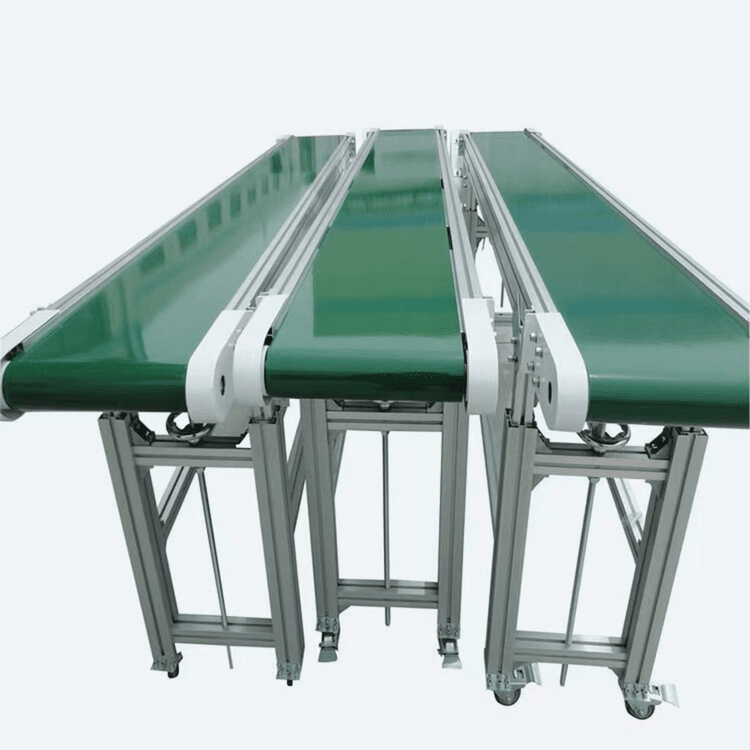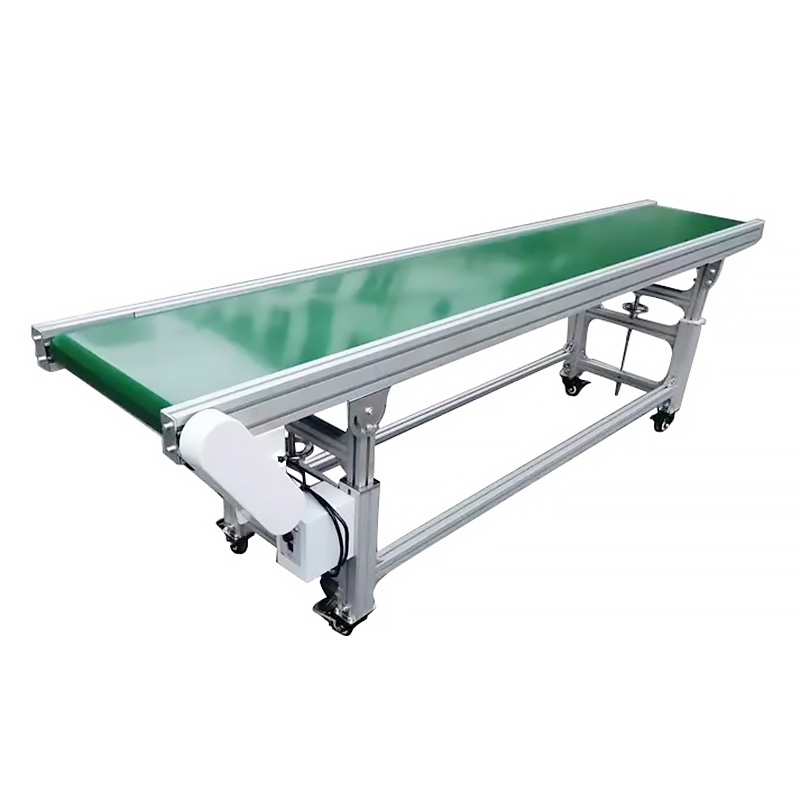Ideal for assembly lines or product handling, aluminum belt conveyors offer an efficient and reliable solution for streamlining workflows and increasing productivity.
Description
Professional حزام النقل Manufacturer
Profiles made from aluminum, in variations like 3030, 4040, 4545, 4590, and 4080. Meanwhile, they serve as the structural foundation for building belt conveyors systems. Moreover, features like adjustable feet for varying heights, connecting brackets, sleek cover profiles. At the same time, versatile modular frames contribute to an aesthetically pleasing and organized facade.
Designed to accommodate a range of operational needs, belt conveyors are constructed. Meanwhile, they are in a spectrum of capacities from light, to medium, to heavy-duty—each meticulously engineered to meet specific usage requirements.

Key Attributes of Belt Conveyor Systems:
1. High Load Capability: A belt conveyor is designed to transport a range of materials—solids, grains, or bulk goods—effortlessly in horizontal, inclined, or vertical paths. The system, we engineer to handle a substantial load, fulfilling diverse material transportation needs.
2. Extensive Reach: Belt conveyors excel in covering long distances, making them ideal for extended transport routes in any direction—horizontal, inclined, or vertical. Their capacity for lengthy hauls positions them as top contenders for transporting minerals and coal over significant expanses.
3. Variable Speed Control: The transport speed of a belt conveyor is modifiable to cater to the material type and journey length, optimizing transportation outcomes. Moreover, speed regulation is feasible using a frequency inverter, allowing for ongoing fine-tuning.
4. Bi-Directional Movement: With the capability for two-way conveyance—forward and reverse—the belt conveyor adapts to particular processing needs and material repositioning demands.
Other Attributes
5. Consistent and Trustworthy Performance: Belt conveyors boast a unified, robust construction that ensures minimal vibration, low noise levels, and steadfast reliability. The integration of a lubricated transmission system minimizes wear on moving parts and cuts down on maintenance costs.
6. Enhanced Conveying Efficiency: Belt conveyors operate with heightened efficiency, capable of automated handling based on material volume and travel distance. This automation reduces manual intervention and supports incessant operation, augmenting production efficacy.
7. Streamlined Design and Maintenance: The construction of belt conveyors is straightforward, featuring fewer parts for hassle-free installation and upkeep. The belt itself is designed for effortless horizontal assembly and disassembly, simplifying routine maintenance and replacements.
8. Versatile Utilization: Belt conveyors are well-suited to a variety of demanding work conditions, be it extreme temperatures, humidity, or corrosive environments, they operate with consistency. Plus, conveying capacity and velocity can be adapted to meet specific operational requirements.
9. Economical Energy Use: Belt conveyors are energy-efficient, with their unique mode of transmission and conveying, leading to lower energy consumption compared to other material handling systems—a cost-effective choice for operations.
In conclusion, belt conveyors are recognized for their robust load-bearing capacity, extensive range, adjustable speeds, and reversible transportation options. Their usage spans across multiple sectors, cementing them as pivotal in material handling.
Alongside these capabilities, they are lauded for their stable performance, simplicity in design and maintenance, adaptability to conditions, and energy efficiency. So that will ensure they meet a vast array of transportation needs. Besides, they offer streamlined solutions for production and logistics challenges.
What are the Advantages of Belt Conveyors?
Belt conveyors have strong conveying capacity, long conveying distance, simple structure and easy maintenance, can easily implement programmed control and automated operation, low cost of use, and have the following characteristics:
- There are many types of materials that we can convey, including various bulk materials, various cartons, packaging bags and other single-piece light-weight products. Moreover, we can use them for commodity conveying at the cashier of large supermarkets, with a wide range of uses
- The structural forms are diverse. Including trough belt conveyors, flat belt conveyors, climbing belt conveyors, tilting belt conveyors, turning conveyors and other forms. Push plates, side baffles, we can also add skirt belts and other accessories to the conveyor belt. So they will meet various process requirements
- The conveyor belt materialof the belt assembly line is rubber, canvas, and other materials. For the conveying of ordinary materials, it can also meet the requirements of oil-resistant, corrosion-resistant, and other materials
- The conveying is smooth, there is no relative movement between the material and the conveyor belt. Besides, it can avoid damage to the conveyed object.
- The structural forms are diverse. Including trough belt conveyor, flat belt conveyor, climbing belt conveyor, adsorption conveyor, turning belt conveyor and other forms.
- The belt conveyor can convey a wide variety of materials, including various bulk materials. Besides, it has a wide range of uses.
- Specifications: we can adopt other special specifications according to customer needs.
- The belt conveyor has a simple structure, is easy to maintain, has low energy consumption and low use cost.
- The special food-grade conveyor belt, we use to meet the requirements of food, pharmaceutical, daily chemical and other industries.
- Compared with other belt conveyors, it has less noise and is suitable for occasions. The occasions require a relatively quiet working environment.
In Conclusion
The aluminum profile belt conveyor is notable for its lightweight design, allowing for effortless repositioning as required. So it is conveniently mobile and ensures a stable transport of goods. Its versatility in application makes it a perfect match for a multitude of industries.
Such as food, cosmetics, pharmaceuticals, and more. So this conveyor system is a valuable asset in product and assembly lines. Therefore, it can enhance production efficiency and seamlessly integrate with manual operations to facilitate a range of assembly tasks.





